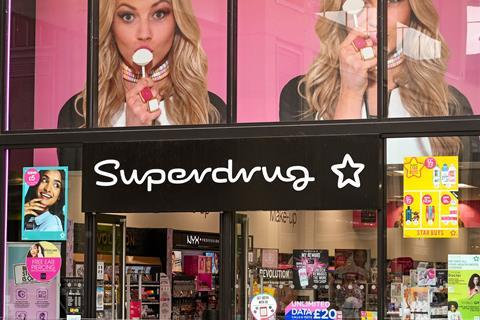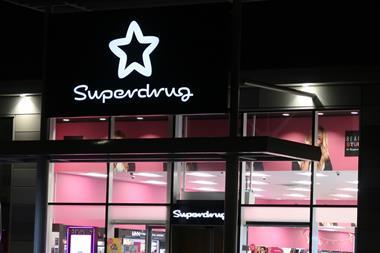As they continue to innovate both on- and offline and right-size their store estates, both retailers’ financial upward trajectories are expected to gain momentum. But which health and beauty retailer will emerge victorious when we put them head to head?
Thanks to the lipstick effect – the psychological theory that people indulge in small, affordable treats during tough times – Boots and Superdrug have largely remained in rude health during the cost-of-living crisis.
But that’s not to say these leaner times have been without challenges. Bottom lines at both retailers have come under pressure in a highly promotional, competitive market.
Profitability has been a key area of focus for Walgreens Boots Alliance (WBA) following its failed efforts to sell off the UK business. Meanwhile, Superdrug has been hard at work driving operational efficiencies.
Both retailers are on store modernisation missions and have made huge strides online too, offering improved wellbeing and related services propositions, marketplaces and enhancements that tie store improvements to digital operations to create effective omnichannel models, fit for the future.
The aging UK population presents a huge healthcare demand in the future that the sector is almost certain to benefit from, with both retailers continuing to increase high street provision on the back of the pandemic, supporting an under-pressure NHS.
Both Boots and Superdrug are on an upward trajectory, but which of the two comes out on top?
Sales and profitability
Superdrug is considerably smaller in revenue terms than Boots, with its sales currently standing at less than a quarter of those posted by its rival.
Both saw declining sales in the 2020 financial year, adversely impacted by the pandemic, with Boots declining 10.8% and Superdrug 14.8%.
But both also made robust, double-digit recoveries. Superdrug bounced back more strongly, growing 17.1% compared with its competitor’s 12%.

However, this year, we welcomed a new beauty competitor into the UK. With just one store up and running and another in the pipeline, Sephora hardly has a big enough UK presence to make much impact on sales just yet, but it has certainly rocked the beauty boat.
In April, Sephora said its new location had performed 300% better than expected, but Boots did not take this challenge lying down. Chief executive Seb James told audiences at Retail Week Live in March that his team had leaned into making Sephora’s launch “a disaster”, revamping its nearest neighbouring store at the same time and seeing an uplift in sales in that location off the back of the French retailer’s much-hyped debut.
When we look ahead, both Boots and Superdrug are set to pack on serious growth. Our analyst team’s forecast reveals that Boots’ compound annual growth rate (CAGR) will see it grow an impressive 6.9% to £9.34bn by 2027.
As it starts from a lower base, Superdrug’s CAGR is slightly higher at 7.1%, which would put it at £1.91bn within five years.
Both retailers have set improved profitability as a necessity, but who has made the most progress?
Due to both companies being part of much larger groups and the inclusion of variable components, it is difficult to directly compare their profitability, but both have delivered a rise.
WBA slapped the ‘For sale’ sign on Boots in January 2022 with a price tag of £7bn, but pulled it off the market six months later after it failed to secure a buyer.
Since then, there has been a sharp focus on improving profitability. In May 2023, WBA slashed 500 HQ jobs and it has had to make tough decisions when it comes to its store estate too.
But this focus appears to be paying off. Operating profit for the Boots UK subsidiary, which includes pharmacy, health and beauty retailing, was £55m in the 2022 financial year, with a margin of 0.8% – up from an operating profit of £8m the previous year and a 0.1% margin. It was also back in the black at a pre-tax level in FY2022.
Superdrug also appears to be making progress. Operating profit for the Superdrug Stores subsidiary was £88.4m in FY2022 with a margin of 6.5%, from an operating profit of £59.6m the previous year and a 5.1% margin.
Online and digital
Another area of development where the two retailers sit neck and neck is digital innovation. Both launched marketplaces in the last year, allowing them to bring on a broader range of products while reducing the overheads and risks associated with holding their own inventories.
Under chief digital officer Paula Bobbett, Boots has been working to replatform its online operations and implement a dynamic, digital overhaul.

As of March 2023, digital investment included more than 25 major technical upgrades in efficiency, stability and customer experience in under a year and a half.
The retailer claims Boots.com is the most visited health and beauty website in the UK and has posted some impressive stats about its app, stating it grew 26% in Q1 2023 and accounts for more than a quarter of Boots.com sales.
Superdrug’s online trading volumes continued to “track significantly ahead of pre-pandemic levels”. Superdrug.com has also been replatformed as it pushes ahead with its “offline plus online” retail approach.
Services have moved up the priority list online and increased demand has seen both Boots and Superdrug build their healthcare provision.
Both retailers report strong growth in their online doctor services, meaning they are now vying for the title of most trusted high street health and beauty retailer.
Stores and fulfilment
The retailers also share a similar focus when it comes to modernising their store estate. This is a significantly bigger job for Boots given the size of its footprint, but each has been working on refreshing stores, right-sizing to offload unprofitable locations and developing and trialling new store formats.
Boots’ scale, however, has worked in its favour when it comes to this modernisation process. Its rapid uptake of cult beauty brands, revamped beauty halls and store upgrades are showing in its performance.
However, the process has also seen some casualties. Boots has reduced its estate by almost 10% since the pandemic and it is planning to lose 300 more stores this year.
Superdrug has cut fewer stores, only reducing its estate by 3% since the pandemic, and it plans to invest in 25 new shops this year.
While it may only have a third of the physical stores that Boots does, its rival’s closures may present an opportunity for Superdrug to snap up these locations and accelerate its own expansion.
Boots is arguably edging ahead on rapid delivery and tie-ups. It has partnered with Uber Eats and Deliveroo, as well as offering click and collect in some 1,600 stores. Meanwhile, Superdrug offers same-day delivery in selected postcodes from 250 stores via its partner Stuart.
Price and loyalty
Catching the wave of price-cutting following the cost-of-living crisis, both retailers have been building on their own-brand beauty ranges and keeping a hold of their prices.
Last November, Superdrug debuted Studio London, a new make-up range all priced under £9 and starting at £3. The retailer also made headlines when it cut VAT from its SPF range in a bid to make suncare more widely accessible during the crisis. And it froze prices on 5,000 branded cosmetics and 150 own-label products as the economic crisis bit over the winter.
Boots invested in its flagship own-label range No7, launching a first-of-its-kind skincare range named Future Renew, which promises to reverse, not just prevent, the signs of aging.
Its approach to price has differed from Superdrug. Instead of freezing prices, it decided to revamp its Advantage Card loyalty scheme, offering member prices and 10% off its own-label ranges. Superdrug has since followed suit, recently launching member prices for its own Health & Beautycard.
Boots’ effort has proven to be hugely successful, with active members standing at 15.4m at the end of 2022, as compared to Superdrug’s total registered card members at 15.7m
Verdict
There’s no doubt that Boots will continue to tower over Superdrug in the future, but it is worth considering that the latter is set to grow faster in the years to come – albeit from a smaller base.
And there is no dismissing the firepower of Superdrug’s parent company AS Watson, which, if it so chose, could put some serious welly into the retailer’s expansion plans where Boots is pulling back – or even take it international.
Both these retailers stand to make huge gains in the future, but with Boots forecast to narrow in on the £10bn mark in the next five years, it emerges as the clear victor in this match.


























No comments yet